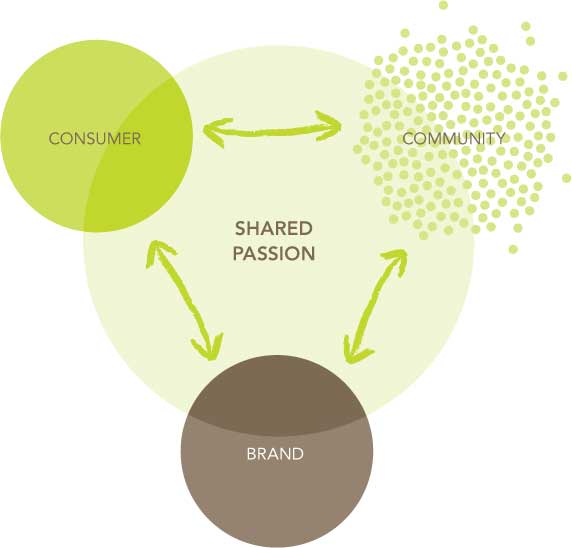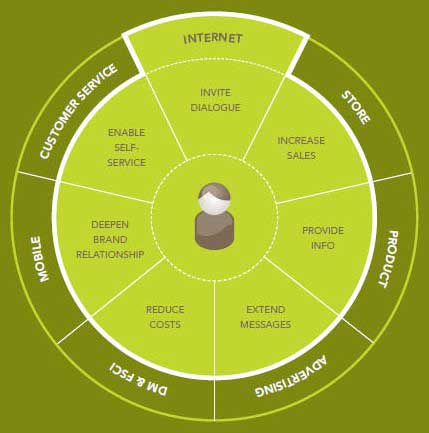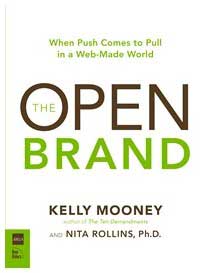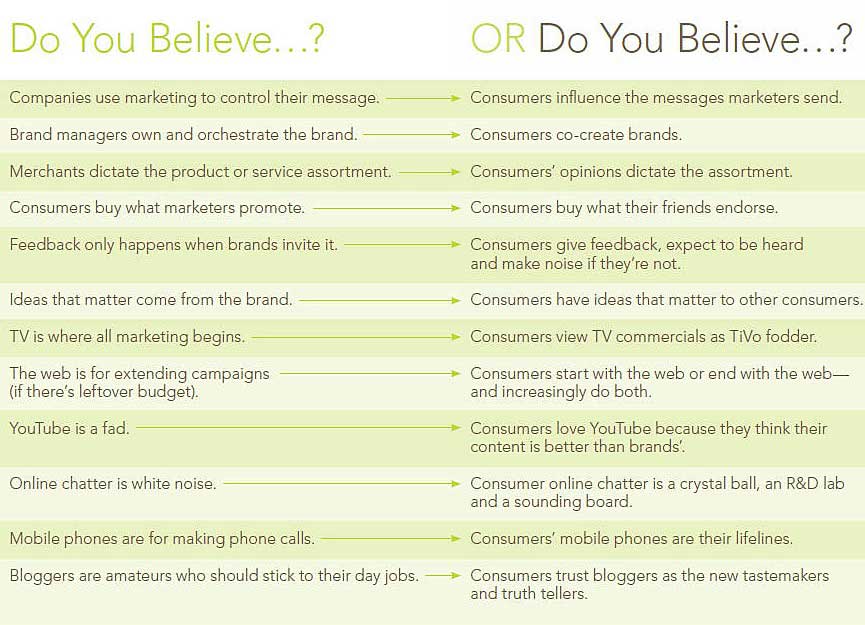When I was on a panel with Kelly Mooney at an AdAge breakfast bites conference in New York, she gave me a copy of the book she co-wrote with Dr. Nita Rollins, The Open Brand: When Push Comes to Pull in a Web-Made World, and I quickly fell in love with it.
The book is a power-packed framework and guide for how brands can thrive and participate in a world where the consumer is the creator.
Mooney and Rollins are on the senior-executive team of one of the largest and oldest digital-marketing shops in North America. I was able to follow up with Mooney to discuss some of the insights and frameworks presented in her book.
SH: I get to read a lot of books on marketing and branding, and I must say that yours really surprised me. Too many of the books I read seem to be nothing more than an attempt to cash in on the brand craze of the last few years.
KM: I think a lot of marketing books aren't written by marketers, quite frankly. A lot of them are written by journalists or academics who aren't necessarily working with brands to solve real problems on real projects. We live in a world where digital is changing the landscape. I wanted this book to present not only a framework but also real tools for marketers to help them begin thinking about opening their brand.
SH: Well, you succeeded. I love this book, and I've been using some of the models you share with my clients with very positive results. I did notice that many of your examples are B2C in nature, so I wanted to explore whether the ideas you present would apply to B2B initiatives.
KM: Everyone wants to think that B2B is a separate, distinct, and unrelated challenge from B2C. I think there is more overlap and more in common than there is different.
We can certainly point to a number of tactical elements used by B2B marketers, such as the use of professional forums, email campaigns, and mobile access to information. However, few B2B companies are truly open, but because of the Web, that's about to change.
Take the model of the Love Triangle presented in the book as an example. It's all about brands meeting consumers at the shared intersection of passion and products—and it completely applies to B2B relationships.
Traditionally in B2B, we think of the trade partner, wholesaler, distributor, specifier, procurement agent, etc.—to the exclusion of the end consumer. However, there is a definite community aspect that can be leveraged.
The Web is that perfect place for B2B to communicate and connect with the end consumer. Not to mention, by leveraging open tools, B2B companies can facilitate and strengthen those vital relationships of trade partner, wholesaler, etc. It's a win all around.
Also important to note is the importance of an emotional connection in an increasingly competitive market. When the choice between alternatives is relatively equal in price and quality, having an emotional connection and relationship with the brand can be the dealmaker. Becoming a more open brand can make the difference.
SH: You talk about engagement from a variety of angles in the book. I wanted to level the field and define that term. A lot of people are bandying the term "engagement" about without a lot of consensus on just what it means. How do you approach and define what is or isn't an "engaging experience"?
KM: In writing the book, I looked to the advertising industry for a common definition, and, in fact, there wasn't one. We define an engaging experience as one that creates the desire for a consumer to spend time with your brand. It isn't simply about getting people to feel something, it's about getting them to feel and do something.
SH: In the book, you devote a chapter to defining the foundational and emerging metrics around digital engagement. I wanted to explore the debate around measurement where traditional players are arguing that there are no standardized measures in digital. How do you see the state of measurement and its ability to report on how effective we are at getting a customer to feel and then do?
KM: It's true. There are no standardized measures. That said, we measure more things more frequently and are much more accountable in digital media, but I don't think we have developed the broader macro measures across channels.
And, to be fair, the traditional advertising space has accepted inadequate measures over the years. It has forgotten about the holes and shortcomings, and simply accepted the current measurement approaches as standards.
In the book, my co-author and I discuss that at the end of the day there are four over-arching business objectives that marketers are really focused on. We identify the accepted foundational metrics for each of those that most companies are already capable of measuring. As an industry, we're working toward a macro set of standards around measurement. I think it's just too soon to lock down what those will ultimately be.
SH: You focus on a variety of strategies to create and measure repeat traffic to a destination brand site. In this world of MySpace, YouTube, and Facebook, is the end game always about generating traffic to a brand's website?

KM: I think that ties into the whole set of principles behind the love triangle presented in our book. You still have to be a brand and a destination, but, in many instances, you aren't going to be the authority. You have to find a way to enable the consumer to talk and help one another—to connect with a community around a shared passion.
It isn't necessarily going to be the "top-down, brand as superhero making it all happen" approach. It may be a quiet, enabling role that could be a sponsorship or a minor branding opportunity.
Take Valspar, a paint company in Wheeling, Ill., and how it has partnered with Beehive Studios, a growing [online] community run by four respected designers who share a point of view around interior design and the environment. Valspar is just an enabler and sponsor for the community. Brands have to learn how to play in those types of relationships much better than they do today.
SH: Isn't that just sponsorship?
KM: Right. But it's a bit new to sponsor bloggers, who used to be seen as crazy, opinionated, out-of-control people. Bloggers are now being recognized as very influential and reasonable people who actually have a point of view and an audience who want to hear about it.
As the corporate take on bloggers shifts, brands find themselves in a difficult position where they have to start rethinking their role in digital media as bottom-up versus top-down—top-down being where the brand controls the message, all the interactions, and we serve up the experience the way we want you to have it. Bottom-up is where the brand is an enabler that provides a toolkit and encourages everyone to talk among themselves, with the brand in the background.
SH: Your book identifies the traits for a successful brand in this emerging digital world and how the best brands propagate a lifestyle "where belonging becomes more important than buying."
The book presents a clear framework on how to create engaging, networked, on-demand, and personal experiences, and even breaks down how different brands have successfully developed unique strategies across those four areas. But what about brands that are inherently unsexy? Will that work for toilet paper?
KM: I think it works for every brand. It's just the combination of strategies and tactics that varies.
Toilet paper—does it work? Could it work? Absolutely. Have you ever tried Charmin Ultra? It rocks! And the people who love it are happy to tell everyone about it.
We recently began working with Gain laundry detergent, and I was blown away by how passionate the brand advocates are. They are so geeked out about the scent and the product, they want to tell everybody, make videos, and be engaged with one another—all on the topic of laundry detergent.
I also think it applies to B2B just as much as, if not more than, B2C. We talk a little about this in the book with Hewlett-Packard and Shaw Floors [of Dalton, Ga.]. Look at Intuit and how it has allowed accountants to help one another. I think we've only begun to change the dialogue and relationships between businesses.
SH: You state that "Brands need to move the digital channel toward their Internet center of gravity" and go so far as to treat "the Internet as Chief Operating Officer." Can you elaborate on this?

KM: Too many people were thinking about the Internet as a single channel—whether it's a distribution channel or a communication channel—when, in fact, the Internet is an enabling platform for change: a platform that can be leveraged to take costs out of your business, to reach more customers, to let customers self-service, to better leverage your assets, and much more.
I think that the Internet and IT are still way too siloed and compartmentalized inside most organizations. Quite frankly, most marketers haven't learned to love technology and to see it as an enabler in solving their problems. Rethinking the role of the Internet in business as a strategic enabler is critical to the future success of any brand.
SH: My hope is that readers of this article will go out and get [embed amazon link] your book[/embed], as I've found it a truly refreshing take on how to approach brands as a digital marketer. But in the interim, what is something that a brand can do right now to begin opening up the brand?
KM: You can begin by determining where you are currently. Are you completely closed? Struggling to open? What's your brand's worldview?
Consider brainstorming. Write down ways in which you think you can be more on-demand for your consumers. How can you be more personal, deepening relationships and better engaging your customers? How can you create a more networked experience by embracing your consumers' communities and fostering relationships?
Before you know it, you'll be on the open road.





